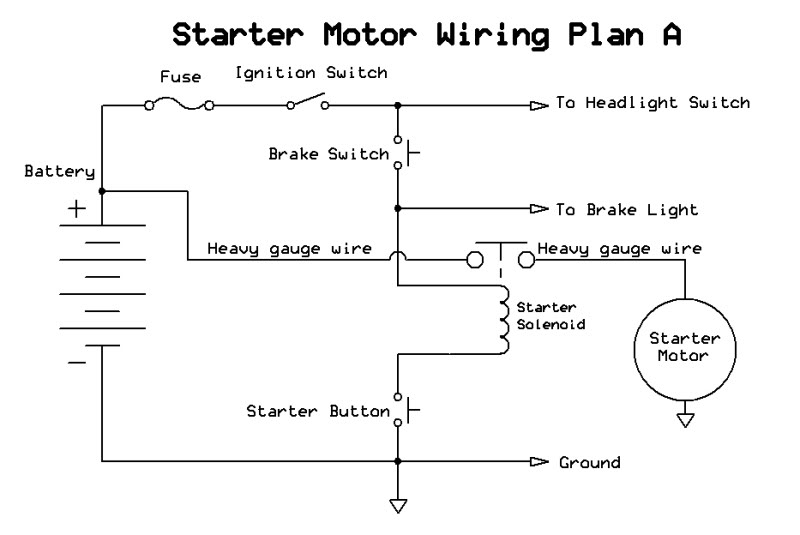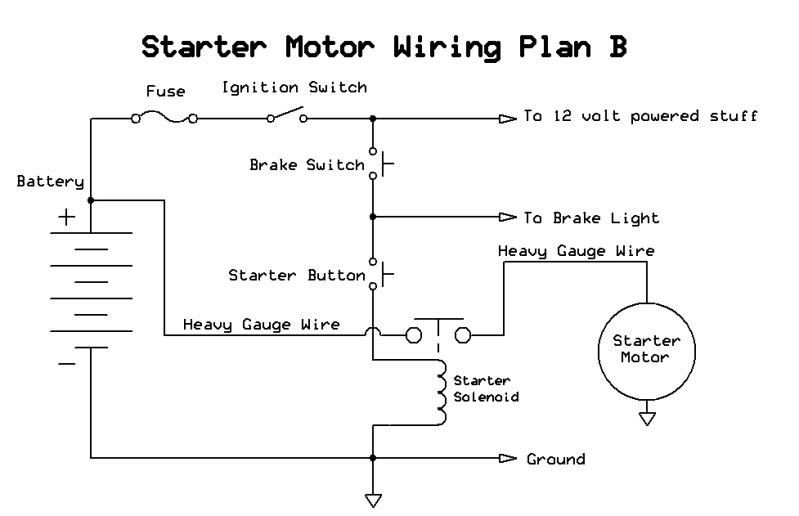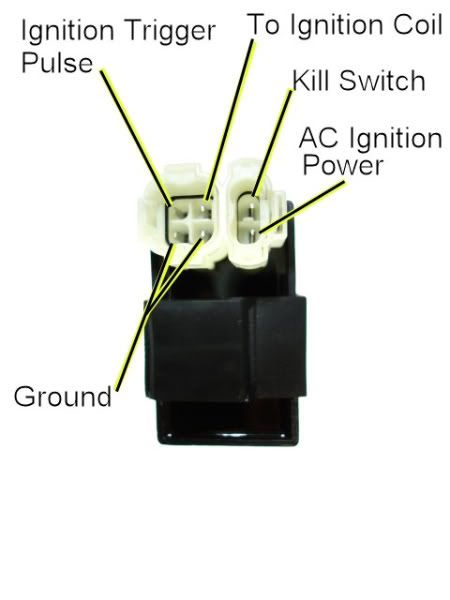What is this ?!
#11
I could not locate the fuse near the battery compartment, and the brake light does not come on, I used a fully charged good battery and better connection to the battery. I got 87-92 volts with the car off and 106-107 volts with the car running. I wasn't sure if u wanted the charging system on the car running or not so I did both
#12
Join Date: Dec 2008
Location: Tracy, California, USA
Posts: 3,260
Likes: 0
Received 12 Likes
on
12 Posts
I would really consider adding an inline fuse that feeds the smaller red wire coming off your battery post. In some instances this smaller red wire comes off the starter solonoid post instead. It isn't going to solve your no spark problem, or solve your starter interlock problem, but if you do something wrong without a fuse you could wipe out a wiring harness in a flash - and maybe start a fire. With a fuse you would just pop it and say "whoops". 10 amps is a good values for a 150cc quad.
Your voltages are on the high side but that is probably a reflection that I just haven't seen that before. It certainly will *not* cause a 'No Spark' problem. Your numbers of 90 volts AC on battery to 107 volts when the engine is running makes sense. The unloaded output voltage from the stator windings are proportional to engine speed. When you car is running the battery voltage is raised to 14.0 volts (from 12.6 volts). The starter spins faster and the output voltage goes up some.
So you have an AC powered ignition system. Here is the generic procedure for troubleshooting that (you've already measured the AC ignition power voltage while cranking...):
Here are the two wiring schemes for the generic starter motor safety interlock circuitry. Yours is probably Plan A:


If you like we can tackle these one at a time, or both simultaneously. Whichever you prefer. You can use the "jumping across the solenoid" method to test all the CDI voltages while cranking....
Your voltages are on the high side but that is probably a reflection that I just haven't seen that before. It certainly will *not* cause a 'No Spark' problem. Your numbers of 90 volts AC on battery to 107 volts when the engine is running makes sense. The unloaded output voltage from the stator windings are proportional to engine speed. When you car is running the battery voltage is raised to 14.0 volts (from 12.6 volts). The starter spins faster and the output voltage goes up some.
So you have an AC powered ignition system. Here is the generic procedure for troubleshooting that (you've already measured the AC ignition power voltage while cranking...):
To troubleshoot no spark problems on a 6 pin AC powered CDI it makes sense to start in the middle (the CDI), measure as much as we can and branch out from there. For the CDI to do its thing it needs power, a trigger pulse, and it must must be inhibited via the kill switch input pin.

1) Unplug the CDI. Turn the ignition switch on. Set all kill switches the the "run" position. In the wiring harness, measure the resistance of the kill switch pin to the ground pin on the 20K ohm scale. It should read infinite ohms (same as when the meter leads are hanging free and not touching anything). It should not read zero ohms (shorted).
2) Leave the CDI unplugged. Use a meter to measure the resistance of the AC ignition power pin in the wiring harness to the ground wire on the 2K ohm scale. You should read approximately 400 ohms. What do you measure?
3) In a similar fashion measure the resistance of the Ignition Trigger Pulse pin to the ground pin. You should see 150 ohms or so. What do you measure?
4) Switch your meter over to measure AC volts on the 200 volt scale. Leave the CDI unplugged. While cranking the engine, measure the voltage on the AC Ignition Power pin in the wiring harness to the ground pin. You should measure 40 to 80 volts AC. What do you measure?
5) Set your meter down to the lowest scale you have for measuring AC volts. 2 volts would be ideal, but some meters don't go that low. In that case use the lowest scale you have. While cranking the engine, measure the voltage on the Ignition Trigger Pulse pin in the wiring harness to the ground pin. You should measure 0.2 to 0.5 volts AC. What do you measure?
6) Now plug the CDI back in. Measure the AC voltage on the Ignition Coil pin to the ground pin using the 200 volt scale. If you have to, use a sewing pin to poke through the wire insulation and then put the meter probe on the sewing pin. But don't hold your fingers on the connection during the next test - there may be high voltage here when the engine is turning. With the ignition on and all kill switches set to the "run" position, crank the starter motor. You should see voltages bouncing around at random values and the meter captures all or part of a spark event. What do you see?

1) Unplug the CDI. Turn the ignition switch on. Set all kill switches the the "run" position. In the wiring harness, measure the resistance of the kill switch pin to the ground pin on the 20K ohm scale. It should read infinite ohms (same as when the meter leads are hanging free and not touching anything). It should not read zero ohms (shorted).
2) Leave the CDI unplugged. Use a meter to measure the resistance of the AC ignition power pin in the wiring harness to the ground wire on the 2K ohm scale. You should read approximately 400 ohms. What do you measure?
3) In a similar fashion measure the resistance of the Ignition Trigger Pulse pin to the ground pin. You should see 150 ohms or so. What do you measure?
4) Switch your meter over to measure AC volts on the 200 volt scale. Leave the CDI unplugged. While cranking the engine, measure the voltage on the AC Ignition Power pin in the wiring harness to the ground pin. You should measure 40 to 80 volts AC. What do you measure?
5) Set your meter down to the lowest scale you have for measuring AC volts. 2 volts would be ideal, but some meters don't go that low. In that case use the lowest scale you have. While cranking the engine, measure the voltage on the Ignition Trigger Pulse pin in the wiring harness to the ground pin. You should measure 0.2 to 0.5 volts AC. What do you measure?
6) Now plug the CDI back in. Measure the AC voltage on the Ignition Coil pin to the ground pin using the 200 volt scale. If you have to, use a sewing pin to poke through the wire insulation and then put the meter probe on the sewing pin. But don't hold your fingers on the connection during the next test - there may be high voltage here when the engine is turning. With the ignition on and all kill switches set to the "run" position, crank the starter motor. You should see voltages bouncing around at random values and the meter captures all or part of a spark event. What do you see?
Here are the two wiring schemes for the generic starter motor safety interlock circuitry. Yours is probably Plan A:


If you like we can tackle these one at a time, or both simultaneously. Whichever you prefer. You can use the "jumping across the solenoid" method to test all the CDI voltages while cranking....
#13
#14
Join Date: Dec 2008
Location: Tracy, California, USA
Posts: 3,260
Likes: 0
Received 12 Likes
on
12 Posts
On #1 make sure that you are reading infinite ohms (or at least greater then than 20K ohms). Not reading zero isn't really good enough. There was a post here recently about someone who measured 600 ohms (0.6K ohms) and that was enough resistance to ground to kill spark.
Other than that, if your sure about your readings, and they are repeatable, then it looks like all the inputs to your CDI are present and working. Yet you have no output from the CDI. That points to a defective CDI, or maybe a shorted ignition coil.
You could measure the resistance of the ignition coil pin in the CDI harness connector to the ground pin in the same connector. That should read something like 0.7 ohms (but not zero ohms). If you do that points even more strongly to the CDI. There is even a more remote chance that you have shorted turns in the ignition coil Secondary windings that destroys the inductance of the ignition coil. But that is so remote I'd bet on the CDI first.
Other than that, if your sure about your readings, and they are repeatable, then it looks like all the inputs to your CDI are present and working. Yet you have no output from the CDI. That points to a defective CDI, or maybe a shorted ignition coil.
You could measure the resistance of the ignition coil pin in the CDI harness connector to the ground pin in the same connector. That should read something like 0.7 ohms (but not zero ohms). If you do that points even more strongly to the CDI. There is even a more remote chance that you have shorted turns in the ignition coil Secondary windings that destroys the inductance of the ignition coil. But that is so remote I'd bet on the CDI first.
#15
My multimeter says O.L when the leads are hanging free , its says the same when checking the kill switch pin. It's like I'm not touching anything at all. The ignition coil pin to ground measures 0 ohms. Also what do I do about the broken pin in the harness ? and thanks for the wiring schematic I'm looking at it as well to figure out the starter interlock problem.
#18
Join Date: Dec 2008
Location: Tracy, California, USA
Posts: 3,260
Likes: 0
Received 12 Likes
on
12 Posts
7 ohms sounds too high. Are you sure it is not 0.7 ohms? What you do get if you measure it right at the ignition coil?
Most ignition coil primaries read less than an ohm. But a while ago someone posted that they measured 1.5 ohms on a working quad. But 7 ohms seems way wide of typical.
So now its down to the CDI or the coil. If you really are measuring 7 ohms then I would suspect the ignition coil first. Else I would suspect the CDI. Fortunately both of these are really inexpensive to change out.
Most ignition coil primaries read less than an ohm. But a while ago someone posted that they measured 1.5 ohms on a working quad. But 7 ohms seems way wide of typical.
So now its down to the CDI or the coil. If you really are measuring 7 ohms then I would suspect the ignition coil first. Else I would suspect the CDI. Fortunately both of these are really inexpensive to change out.
#19
I selected the lowest scale and I used the auto range mode, both came out the same, its definitely 7.0 not 0.7. Is there a certain website you would recommend for parts ? Do they have the a replacement pin for the ground wire in the harness as well ? Do I need to have any more information than the motor type?
#20
Join Date: Dec 2008
Location: Tracy, California, USA
Posts: 3,260
Likes: 0
Received 12 Likes
on
12 Posts
Im not sure about the ground wire pin. Does this go to a connector somewhere, or is it just a ground lug that bolts to the frame? If it is a pin the connector, does it tie directly to a module (no pigtail wires - the connector is embedded in the module)? Or does this pin in the connector tie to a pin in a mating connector that is also a wire?
Does this site look like is has anything you need?:
Electric Scooter Wire Connectors - ElectricScooterParts.com
The above link was sent to me by someone else.
As far as your CDI and Ignition coil: You have an AC powered 6 pin CDI. Look for the words "AC powered" and match up the picture (note the rounded corners in the connectors). If the vendor says their CDI works on AC and DC, or if they don't specify which, then avoid them like the plague. It means they don't have a clue as to what they are selling. Ignition coils for 4 strokes are electrically the same on 110cc machines, 150cc machines and 250cc machines. The coil is tuned to the CDI, so any quad that uses the same CDI can use the same coil - as long as will mechanically mount up. 110cc machine use a 5 pin CDI which looks much different, but after taking one apart I can say for a fact that they are exactly the same inside except for the connectors.
Use google to search reviews on any vendor you are thinking of dealing with. Pick your best shot and try it. It's not like you're risking a lot of money . And if you get screwed complain. eBay and Amazon have internal feedback avenues. Outside of that there is Yelp, Epinions, and others. If everyone would just check the reputation of a vendor before using them they will soon be out of business if they are clueless or shady.
. And if you get screwed complain. eBay and Amazon have internal feedback avenues. Outside of that there is Yelp, Epinions, and others. If everyone would just check the reputation of a vendor before using them they will soon be out of business if they are clueless or shady.
Does this site look like is has anything you need?:
Electric Scooter Wire Connectors - ElectricScooterParts.com
The above link was sent to me by someone else.
As far as your CDI and Ignition coil: You have an AC powered 6 pin CDI. Look for the words "AC powered" and match up the picture (note the rounded corners in the connectors). If the vendor says their CDI works on AC and DC, or if they don't specify which, then avoid them like the plague. It means they don't have a clue as to what they are selling. Ignition coils for 4 strokes are electrically the same on 110cc machines, 150cc machines and 250cc machines. The coil is tuned to the CDI, so any quad that uses the same CDI can use the same coil - as long as will mechanically mount up. 110cc machine use a 5 pin CDI which looks much different, but after taking one apart I can say for a fact that they are exactly the same inside except for the connectors.
Use google to search reviews on any vendor you are thinking of dealing with. Pick your best shot and try it. It's not like you're risking a lot of money
 . And if you get screwed complain. eBay and Amazon have internal feedback avenues. Outside of that there is Yelp, Epinions, and others. If everyone would just check the reputation of a vendor before using them they will soon be out of business if they are clueless or shady.
. And if you get screwed complain. eBay and Amazon have internal feedback avenues. Outside of that there is Yelp, Epinions, and others. If everyone would just check the reputation of a vendor before using them they will soon be out of business if they are clueless or shady.

